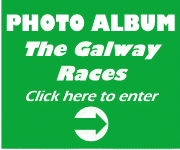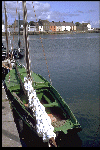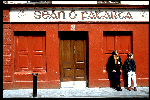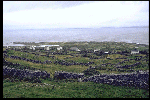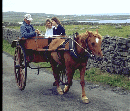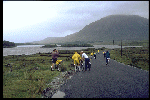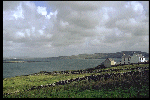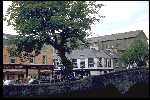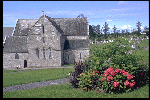|
|
||||||||||
|
IRELAND
1. Galway and Connemara
Galway-Aran
Islands-Carna-Leenane-Westport-Cong- Galway.
MAP
Click on thumbnails to zoom
Does every country have a
region that is like a sort of distilled version of it, a concentrate of its
qualities or a compendium of its identity? Perhaps, as it happens for every
stereotype, it' s the insistence with which it keeps coming back that does
the trick. In any case, it's a fact that when many foreigners think of Italy
the images conjured up by their imagination are actually those of Tuscany.
For France, it may be Burgundy, for Germany, Bavaria, for Spain, Andalusia,
and so on. Am I trying to prove something here? Not really, I just wanted to
introduce the destination of this tour: if one were to choose Ireland to
verify the theory mentioned above, the least one can say is that Connemara
would be the first name on his test docket.
We start our tour in Galway,
a sort of capital of West Ireland. (I don' know, are there other
contenders?). Among the many things worth mentioning in Galway (for the
Races, see photo album), there's one in
which a fellow citizen of mine is involved. Guglielmo Marconi,
according to a stone set at the entrance of the harbour, realized from here
one of the first experiments of trans-oceanic wireless communication. Marconi
would have undoubtedly appreciated the development that trans- oceanic
communications have seen around here, even taking into account the comeback
of the wire that originated it. If Europe had a border with the United
States, it would run around here, a cyber-frontier that would in fact be more
open than the Schengen Area customs.
All things considered, as far
as technologies go the Web is one of the most discreet. Thanks to it, there
may no longer be places that one can describe as remote, and yet it doesn't
prevent those places to retain outwardly a remote appearance. One of
the places that I trust will take full advantage of this opportunity are the Aran
Islands. Once one of the most isolated places of Europe, today they could
propose to enter some sort of administrative partnership with the town
council of, say, Marta's Vineyard without making it sound excessively
outrageous.
Yet for us cycling around Inishmore
felt just like the real thing, namely, land's end, and never more so than
when, at its westernmost tip, the road ended abruptly and in front of us
there was nothing but sea (even if the visibility was reduced to perhaps half
a mile). Undoubtedly the fact that the weather was dismal helped. Drenched to
the bone, we could more easily identify with the old Aran islanders portrayed
by Robert Flaherty in the classical documentary Man of Aran. A local
theatre that shows the film around the clock provides also a welcome shelter
against bad weather, and we heartily applaud the decision to stint on the
projector and splurge on the heating.
The next day, taking advantage
of the improved weather, we start off from Rossaveal for a tour around
the headlands and inlets that give to this part of the Irish coast a
decidedly meandering appearance. Basically we follow the road that circles Kilkieran
Bay. We enter the Rosmuck Peninsula and stop to pay homage to one
of Ireland independence fighters by visiting Pearse's Cottage. As
famous as he is in Ireland, Padraig Pearce would certainly be better
know around the world today if they had added just half an hour at the
beginning of Michael Collins. Competing the other half of the Bay tour
we arrive in Carna to end this day's ride.
The following day's route takes
us across the heart of Connemara. Unfortunately, our ride is beset by the
kind of bad weather that is apparently so typical of these parts. The weather
keeps getting worse as we approach the most interesting stretch of road, that
cuts across two ranges of mountains (more like hills, in fact, if one was to
judge by their elevation, but I imagine there are other criteria): the Twelve
Bens, and the Maamturk Mountains. The Twelve Bens in particular
are a wilderness area still very much unspoilt.
Since we keep to the
paved road, we only skirt them but, considering the kind of day that we are
having, we are just content with that. We make a detour to Kylemore Abbey
where we get a short respite in the stately buildings. Our final destination
however is still some kilometres away, in Leenane, a stretch that we
cover under a relentless downpouring. We would surely appreciate the sight of
the scenic Killary Harbour more, if it wasn't for the thought that
there's nothing in it but still more water. If the better way to describe the
weather around here is: unpredictable, it follows that there's at least one
thing you can be sure of: it's going to change. As predictable as a Swiss
town clock striking twelve, the sun shines on the next day for the better
part of our ride.
Our route crosses the northern
part of Connemara and takes us to the seaside again on the vast gulf of Clew
Bay. We follow the coast until we arrive in Westport. Just before
entering the town, on our left appears the rather imposing mass of Croagh
Patrick, St. Patrick's Hill (sorry, Mountain...), the final destination
of one of Ireland's most important pilgrimages. Even the sceptic that chooses to follow the faithful to the top
will be rewarded with a spectacular view of the bay and its countless islands
(actually, according to some traditions, there should be 365 of them, as many
as the days in one year -do they have a floating one they bring in on leap
years?). In Westport I discover that my decision to postpone my shopping
turns out to have been the right one, considering the opportunities that the
town offers to stock up on Irish crafts.
We have still two
days of cycling to get back to Galway, and this time we leave the sea behind
for good and, heading south, we cycle along Connemara's eastern border, where
the watery part of the scenery is provided by two big lakes, the Lough
Mask and the Lough Corrib. Before getting there we make a stop to
visit Ballintubber Abbey, among whose notable features, we are told,
is the fact that it has retained its roof (or has had it restored, whatever).
Apparently the fact that so many ancient Irish churches are on open air, so
to say, has something to do with Cromwell. This man showed apparently
some sort of evil genius in his decision to allow his religious adversaries
to worship only on sunny days. Given the weather here, the resentment it
created is understandable.
There's no trace of roof in the
Abbey of Cong, but ignore if Cromwell has something to do with it. To
tell the truth, there isn't much trace left of the walls either. On a less
contentious note, the surroundings of Cong provided the set for the shooting
of John Ford's The Quiet Man (John Wayne must have agreed to play an
Irish film when he learned that it was in the west of Ireland).
Another more recent film set in Connemara is The Field, directed by
Jim Sheridan (with Richard Harris and Tom Berenger, among others), and with
this information we go back to our original question: is there something as a
region that contains the characters of a whole nation? Well, if they make so
many movies in it, maybe we are getting close to some answer here, what do
you think? Click
here to go to Part II: Kerry and Cork.
[Home Page]-|-[ France]-|-[ Ireland]-|-[ Italy]-|-[ Germany]-|-[ Scotland]-|-[ United States]
|


